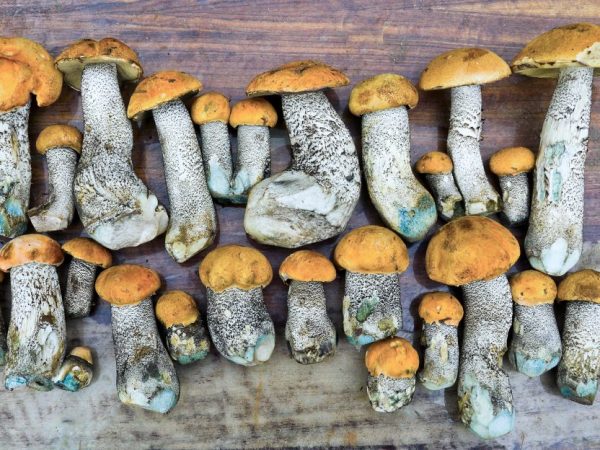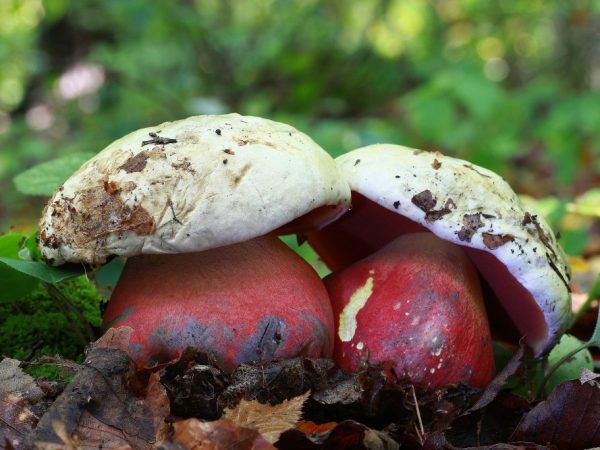Mushrooms with blue cut
In the forest, you have to apply in practice all the theoretical knowledge gained, determining the edibility of the crop. If the mushroom turns blue on the cut, it is necessary to understand whether it can be harvested, is it safe?

Mushrooms with blue cut
Features of picking mushrooms
Poisoning with poisonous mushrooms can lead not only to a disorder of the digestive system, but also to severe intoxication of the body with poisons, leading not only to health problems, but even death. Therefore, one should go to the forest for mushrooms armed with a sufficient supply of knowledge about the characteristics of edible mushrooms found in this area, their appearance, places of growth and harvesting seasons.
Noticing that the mushroom turns blue on the cut, and having some knowledge, it is easy to determine its nutritional value and effect on the body.
Nature has endowed many organisms with similar features, so the best way to avoid the sad consequences is to study the differences between each species and follow the basic rules of collection:
- it is better for a beginner to go to the forest for mushrooms accompanied by more experienced comrades;
- collection points are chosen far from highways, industrial enterprises and environmentally polluted places, because all mushrooms are capable of accumulating toxins from the environment (only in different quantities);
- only young, intact specimens are collected, avoiding old and overripe ones that have low taste indicators;
- if there is the slightest doubt about the suitability of the mushroom for consumption, it is left in place so as not to spoil the entire harvested crop and not endanger your health.
Types of mushrooms
Examining a mushroom that comes across, pay attention to its size and shape, the color of the fruiting body, the structure of the cap and legs, aroma, color of the plates and pulp at the break. One of the features of these organisms is the ability of the pulp to change color when damaged, which occurs due to the oxidation of certain substances in the air (more precisely, with the participation of atmospheric oxygen).
If the mushroom turns blue on the cut, it is carefully examined to determine the species. Both edible and poisonous specimens have this ability.
The opinion that blue discoloration is a sign of the presence of toxins in the fruiting body is erroneous.
Edible varieties
Of the edible popular species, the ability to turn blue on the cut are boletus, oak, Polish mushrooms, as well as a mushroom listed in the Red Book with the strange name "bruise" - blue gyroporus. Their main characteristics are as follows:
- Aspen mushrooms: are considered valuable and tasty products, they have many varieties. One of them is red or red-headed. The leg of the mushroom turns blue on the cut, and after a while it becomes black. Outwardly, it is noticeable and bright. The cap of an adult fetus is cushion-shaped, up to 30 cm in diameter. It has a red-brick color, the surface of the fruit is smooth and velvety in dry weather. Its leg is thick and massive, has a scaly surface. Grows in deciduous forests, at the base of aspen trunks.
- Speckled oak tree: belongs to the Boletovye family.The hat is large, pillow-shaped, of an irregular gray-yellow color. The leg is thick at the base, with a mesh surface. When damaged, the yellowish pulp quickly turns blue-green, and then turns black. It is found mainly under oak and linden trees.
- Polish porcini mushroom: valuable and rare representative. It has a convex cap up to 12 cm in diameter, which becomes almost flat in adulthood. Color - from light brown to brown. The leg is straight, slightly thickened at the base. The pulp is firm, with a yellow tinge. If damaged, the mushroom first turns blue on the cut, then becomes brown, has a pleasant mushroom smell.
- Bruise: a bright representative of the Pig family. It has a wide and almost flat cap ranging in size from 5 to 15 cm, from white-yellow to brown-gray. Its surface in an adult specimen is slightly cracked. The leg is low, up to 10 cm, cylindrical in shape. When broken, the flesh changes color from white to bright blue.
Irina Selyutina (Biologist):
Blue gyroporus is rarely found in Europe and North America. In the post-Soviet space, it can be found in the European part of the former USSR, in the Caucasus and the Far East. Due to its limited distribution across the territory of Russia, the bruise mushroom is known only to a small number of fans of "quiet hunting". However, it can be an excellent base for preparing a wide variety of mushroom dishes. In dried form, the aroma of gyroporus increases several times (water leaves, only dry components of the pulp remain) and the mushroom can be used as a seasoning after grinding into a powdery mass using a coffee grinder or a hand mill for spices.
These edible mushrooms, like a number of others, are mycorrhizal formers with various types of representatives of woody vegetation, giving each other the opportunity to fully exist, because fungi supply water and minerals from the soil, and plants "give" part of the polysaccharides synthesized in the process of photosynthesis.
Poisonous representatives

Satanic mushroom turns blue when damaged
There are also poisonous mushrooms that tend to turn blue when damaged. Their brightest representative is the satanic mushroom. It is rare, but has a striking appearance. Its cap reaches 30 cm in diameter, has a convex-outstretched shape and a velvety surface. Its color is white-gray, sometimes it has a yellowish tint. The leg is high and massive, barrel-shaped. The mushroom immediately turns blue on the cut, then the pulp becomes pinkish.
Another mushroom from the genus Butter is a yellow-brown flywheel, it belongs to the conditionally edible species. It will not cause severe poisoning, but if improperly processed, it can provoke problems with the gastrointestinal tract. The fruit body is small, the cap is convex in shape, tucked along the edges. The yellowish-brown surface of the cap with small scales is slippery and sticky. The leg is smooth, from 3 to 10 cm in height. If you press on the spongy layer under the cap, it takes on a blue tint.
The most dangerous and poisonous are pale toadstool, fly agaric, false foam, gall mushroom and others. You should beware of them and know the peculiarities of their description. Such a mushroom never turns blue when cut.
Eating
Mushrooms are a healthy and nutritious natural product. They contain a large amount of vitamins, minerals and essential amino acids. As a low-calorie product, mushrooms are used in dietary and vegetarian diets. And their high protein content has made them popular in special sports diets. In addition, the nutrients and compounds contained in mushrooms are successfully used in folk and traditional medicine.
Fruit bodies that change the color of the flesh to blue are not always unusable and dangerous to eat.
Conclusion
When picking mushrooms in the forest, you must very carefully and carefully inspect each cut specimen before sending it to the basket.Color change when the fruit body is damaged is not an indispensable sign of its danger. Only knowledge of all the characteristics in the complex will allow you to navigate and make the right choice.



